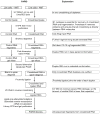PARIS: Psoralen Analysis of RNA Interactions and Structures with High Throughput and Resolution
- PMID: 29130190
- PMCID: PMC5821472
- DOI: 10.1007/978-1-4939-7213-5_4
PARIS: Psoralen Analysis of RNA Interactions and Structures with High Throughput and Resolution
Abstract
RNA has the intrinsic propensity to form base pairs, leading to complex intramolecular and intermolecular helices. Direct measurement of base pairing interactions in living cells is critical to solving transcriptome structure and interactions, and investigating their functions (Lu and Chang, Curr Opin Struct Biol 36:142-148, 2016). Toward this goal, we developed an experimental method, PARIS (Psoralen Analysis of RNA Interactions and Structures), to directly determine transcriptome-wide base pairing interactions (Lu et al., Cell 165(5):1267-1279, 2016). PARIS combines four critical steps, in vivo cross-linking, 2D gel purification, proximity ligation, and high-throughput sequencing to achieve high-throughput and near-base pair resolution determination of the RNA structurome and interactome in living cells. In this chapter, we aim to provide a comprehensive discussion on the principles behind the experimental and computational strategies, and a step-by-step description of the experiment and analysis.
Keywords: 2D gel electrophoresis; AMT (4′-aminomethyltrioxsalen hydrochloride); Cross-linking; High-throughput sequencing; Proximity ligation; Psoralen; RNA structure; RNA–RNA interaction.
Figures






Similar articles
-
Mapping RNA-RNA Interactions Globally Using Biotinylated Psoralen.J Vis Exp. 2017 May 24;(123):55255. doi: 10.3791/55255. J Vis Exp. 2017. PMID: 28570509 Free PMC article.
-
RNA Duplex Map in Living Cells Reveals Higher-Order Transcriptome Structure.Cell. 2016 May 19;165(5):1267-1279. doi: 10.1016/j.cell.2016.04.028. Epub 2016 May 12. Cell. 2016. PMID: 27180905 Free PMC article.
-
Psoralen crosslinking between human immunodeficiency virus type 1 RNA and primer tRNA3(Lys).Nucleic Acids Res. 1996 Feb 1;24(3):509-14. doi: 10.1093/nar/24.3.509. Nucleic Acids Res. 1996. PMID: 8602365 Free PMC article.
-
Dawn of the in vivo RNA structurome and interactome.Biochem Soc Trans. 2016 Oct 15;44(5):1395-1410. doi: 10.1042/BST20160075. Biochem Soc Trans. 2016. PMID: 27911722 Review.
-
RNA Conformation Capture by Proximity Ligation.Annu Rev Genomics Hum Genet. 2020 Aug 31;21:81-100. doi: 10.1146/annurev-genom-120219-073756. Epub 2020 Apr 22. Annu Rev Genomics Hum Genet. 2020. PMID: 32320281 Review.
Cited by
-
RNA contributions to the form and function of biomolecular condensates.Nat Rev Mol Cell Biol. 2021 Mar;22(3):183-195. doi: 10.1038/s41580-020-0264-6. Epub 2020 Jul 6. Nat Rev Mol Cell Biol. 2021. PMID: 32632317 Free PMC article. Review.
-
The Functional Meaning of 5'UTR in Protein-Coding Genes.Int J Mol Sci. 2023 Feb 3;24(3):2976. doi: 10.3390/ijms24032976. Int J Mol Sci. 2023. PMID: 36769304 Free PMC article. Review.
-
Harnessing Molecular Recognition for Small-Molecule-Mediated Reversible Photochemical Control Over mRNA Translation.Angew Chem Int Ed Engl. 2025 May 26;64(22):e202503078. doi: 10.1002/anie.202503078. Epub 2025 Apr 22. Angew Chem Int Ed Engl. 2025. PMID: 40163345 Free PMC article.
-
Secondary Structural Model of Human MALAT1 Reveals Multiple Structure-Function Relationships.Int J Mol Sci. 2019 Nov 9;20(22):5610. doi: 10.3390/ijms20225610. Int J Mol Sci. 2019. PMID: 31717552 Free PMC article.
-
Uncovering Novel Viral Innate Immune Evasion Strategies: What Has SARS-CoV-2 Taught Us?Front Microbiol. 2022 Mar 23;13:844447. doi: 10.3389/fmicb.2022.844447. eCollection 2022. Front Microbiol. 2022. PMID: 35401477 Free PMC article. Review.
References
Publication types
MeSH terms
Substances
Grants and funding
LinkOut - more resources
Full Text Sources
Other Literature Sources
Miscellaneous

